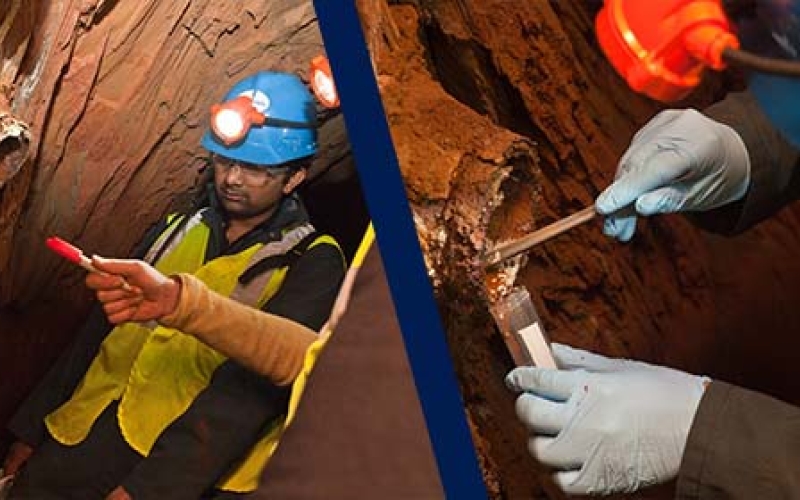
Regan DeBoer, a senior studying geology at South Dakota Mines takes a water sample at SURF.
If you have ever reeled at the taste of tap water when traveling in a new place, you’ve found first-hand that water is not the same everywhere. This is part of what two researchers are exploring with a new project using samples of water collected inside the Sanford Underground Research Facility (SURF).
The water underground at SURF is unique in that it sometimes contains extremophiles, microbes that live in extreme places on earth. Extremophiles are found in places such as the hot springs of Yellowstone, hydrothermal vents at the bottom of the ocean, and the ground water that seeps into tiny cracks deep inside the earth.
Extremophiles are valuable to biologists because they have evolved unique properties that allow them to thrive in resource-poor environments. These properties make them excellent candidates for a host of applications, from the creation of new antibiotics to biofuels to biodegradable plastics, and more.
“There has been a lot of interest in searching for and understanding the microbes that live in SURF and the value these extremophiles have for science. But there has been less work on characterizing the chemistry of the water that they're living in at SURF," said Dr. Scott Beeler, a research scientist at South Dakota Mines, and the principal investigator on the study. “And so, what we're doing is filling in data gaps in water chemistry.”
Dr. Sarah Keenan, a geochemist and assistant professor of geology and geological engineering at South Dakota Mines is the co-principal investigator on the research alongside Beeler. Their characterization of the water at SURF includes a suite of scientific instruments located in Keenan’s laboratory and at the Engineering and Mining Experiment Station located at South Dakota Mines.

Photo by Dr. Scott Beeler, South Dakota Mines
In a nutshell, preliminary findings show that water chemistry varies widely throughout SURF providing numerous types of habitats for microbial life. “For example, the amount of elements in the water such as iron and manganese, which microorganisms can use as a source of energy, have over a thousandfold range in concentrations across different locations in SURF,” says Beeler. While the current work is focused on determining the amount of variability in water chemistry at SURF, the ultimate goal is to understand what controls this variability. “We're hoping to piece together the different water chemistry and how it might relate to the different types of rocks the water is interacting with underground at SURF. This can help us understand the types of microbial life different sites underground might be hosting,” Keenan said.
The research might even have value in a future search for extraterrestrial life. This kind of study can show the types of water chemistry life favors. “And that’s important because you might have instrumentation on future satellites, a spacecraft, or a rover on a distant moon that can test chemistry without being able to do an entire range of microbial sequencing,” Beeler said.
Beeler and Keenan’s research is funded by the NASA South Dakota Space Grant Consortium. The research involves students at Mines who are gathering samples from various sites underground at SURF and testing those samples in labs at Mines.
Reghan DeBoer is a senior studying geology at Mines who was also an intern at SURF in the summer of 2022. For DeBoer, the opportunity to take part in this kind of study is valuable.
“I love being able to help on this research, and I love going underground at SURF and learning how to use the testing equipment,” DeBoer said. “I’m taking an aqueous geochemistry class right now and this hands-on experience is really helping me connect that classroom work with the real world.”
A fellow student on the project Riley Kortenbusch, agreed. He is a sophomore studying geology at Mines. “I’m just getting introduced in my core geology classes and this gives me a chance to practice geochemistry to see if this is an area I want to pursue. It’s a little out of my wheelhouse – but this real-world experience also helps me connect and fill in the gaps I might be missing in my classroom,” Kortenbusch said.

Photo by Dr. Scott Beeler, South Dakota Mines
The NASA South Dakota Space Grant Consortium grant funding this five-month study is intended to help researchers gather preliminary data needed to make the case for a larger project.
“So that's exactly what we're doing,” Beeler said. “Hopefully, if our story and the data we collect is compelling enough, we will have enough for a proposal to do more of this extensive geochemical sampling underground in the Black Hills."
Besides SURF, the team is also taking water samples from multiple caves around the Black Hills. These caves are generally more shallow and in different types of rock than the sampling locations at SURF, but still hold unique and rare forms of microbial life. The effort is to build a better understanding of water chemistry and life in a broad area.



